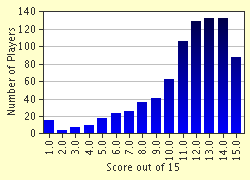Quiz Answer Key and Fun Facts
1. Which of the following countries does Romania NOT border on?
2. What is the approximate population of Bucharest (official EU 2015 estimate)?
3. On what river is Bucharest?
4. What is Romania's main mineral resource?
5. What is the largest religious denomination in Romania?
6. What family of languages does Romanian belong to?
7. In which neighboring country is Romanian widely spoken?
8. Romania has various ethnic minorities. As far as can be established, which is the largest?
9. From AD106-271 the present territory of Romania was part of the Roman Empire. What did the Romans call it?
10. When did Romania first achieve full, internationally recognized independence from the Ottoman (Turkish) Empire?
11. A question on Romania in the two World Wars. Which of the following statements is correct?
12. From 1927-44 Romania had a powerful Fascist party officially called the 'Legion of the Archangel Michael'. What was its paramilitary wing called?
13. Nicolae Ceausescu, the neo-Stalinist dictator of Romania from 1965-89, was overthrown in December 1989. Which Romanian city was most closely associated with the early protests against his regime?
14. From 1966 onwards Ceausescu was worried about Romania's falling population. What measure(s) did he take to boost the birthrate?
15. Nicolae Ceausescu and his wife Elena were court-martialled and shot on Christmas Day, 1989.
Source: Author
bloomsby
This quiz was reviewed by our editing team before going online.
Any errors found in FunTrivia content are routinely corrected through our feedback system.
